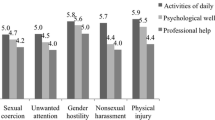Abstract
A new model of the etiology of sexual harassment,the four-factor model, is presented and compared with several models of sexual harassment including the biological model, the organizational model, the sociocultural model,and the sexrole spillover model. A number of risk factors associated with sexually harassing behavior are examined within the framework of the four-factor model of sexual harassment. These include characteristics of the work environment (e.g., sexist attitudes among co-workers, unprofessional work environment, skewed sex ratios in the workplace, knowledge of grievance procedures for sexual harassment incidents) as well as personal characteristics of the subject (e.g., physical attractiveness, job status, sexrole). Subjects were 266 university female faculty, staff, and students who completed the Sexual Experience Questionnaire to assess the experience of sexual harassment and a questionnaire designed to assess the risk factors stated above. Results indicated that the four-factor model is a better predictor of sexual harassment than the alternative models. The risk factors most strongly associated with sexual harassment were an unprofessional environment in the workplace, sexist atmosphere, and lack of knowledge about the organization's formal grievance procedures.
Similar content being viewed by others
REFERENCES
Bem, S. L. (1974). The measurement of psychological androgyny. J. Consult. Clin. Psychol. 42: 155–162.
Cammaert, L. (1985). How widespread is sexual harassment on campus? Int. J. Women's Stud. 8: 399–397.
Dansky, B. S., and Kilpatrick, D. G. (1997). Effects of sexual harassment. In O'Donohue, W. T. (ed.), Sexual Harassment: Theory, Research and Treatment, Allyn and Bacon, Boston, pp. 152–174.
Ellis, S., Barak, A., and Pinto, A. (1991). Moderating effects of personal cognitions on experienced and perceive d sexual harassment of women at the workplace. J. Appl. Soc. Psychol. 21: 1320–1337.
Farley, L. (1978). Sexual Shaked own: The Sexual Harassment of Women on the Job, McGraw-Hill, New York.
Finkelhor, D. (1984). Child Sexual Abuse: New Theory and Research, Free Press, New York.
Fitzgerald, L. F., and Ormerod, A. J. (1991). Perceptions of sexual harassment: The influence of gender and academic context. Psychol. Women Quart. 15: 281–294.
Fitzgerald, L. F. and Shullman, S. L. (1993). Sexual harassment: A research analysis and agenda for the 1990's. J. Vocat. Behav. 42: 5–27.
Fitzgerald, L. F., Shullman, S., Bailey, N., Richards, M., Swecker, J., Gold, Y., Ormerod, A. J., and Weitzman, L. (1988). The incidence and dimensions of sexual harassment in academia and the workplace. J. Voc. Behav. 32: 152–175.
Fowler, F. J., Jr. (1988). Survey Research Methods, Sage, Beverly Hills, CA.
Gelfand, M. J., Fitzgerald, L. F., and Drasgow, F. (1993). The structure of sexual harassment: A confirmatory analysis across cultures and settings. Under review.
Gruber, J. E. (1990). Methodological problems and policy implications in sexual harassment research. Population Res. Polit. Rev. 9: 235–254.
Gruber, J. E. (1997). An epidemiology of sexual harassment: Evidence from North American and Europe. In O'Donohue, W. (ed.), Sexual Harassment, Allyn and Bacon, Boston, pp. 152–174.
Gutek B. A. (1985) Sex and the Workplace. Jossey-Bass, San Francisco.
Gutek, B. A., and Dunwoody, V. (1988). Understanding sex and the workplace. In Stromberg, A. H., Larwood, L., and Gutek, B. A. (eds.), Women and Work: An Annual Review, Vol. 2, Sage, Newbury Park, CA.
Gutek, B. A., and Koss, M. P. (1993). Changed women and changed consequences of and coping with sexual harassment. J. Vocat. Behav. 42: 28–48.
Gutek B. A., and Morasch, B. (1982). Sex-ratios, sex-role spillover, and sexual harassment of women at work. J. Soc. Issues, 38: 55–74.
Lafontiane, E., and Tredeau, L. (1986). The frequency, source s, and correlates of sexual harassment among women in traditional male occupations. Sex Roles, 15: 433–41.
Loy, P. H., and Stewart, L. P. (1984). The extent and effects of the sexual harassment of working women. Soc. Focus 17: 31–43.
MacKinnon, C. (1979) Sexual Harassment of Working Women: A Case of Sex Discrimination, Yale University Press, New Haven, CT.
Powell, G. N. (1986). Effects of sex role identity and sex on definitions of sexual harassment. Sex Roles, 14(1,2): 9–19.
Rand, C. S., and Hall, J. A. (1983). Sex difference s in the accuracy of self-perceived attractiveness. Soc. Psychol. Quart. 46: 359–363.
Scheidner, K. T., and Swan, S. (1994). Job-related, psychological, and health-related outcomes of sexual harassment, Paper presented at the Ninth Annual Conference of the Society of Industrial and Organizational Psychology, Nashville, TN.
Tangri, S. S., Hayes, S. M. (1997). Theories of sexual harassment. In O'Donohue, W. (ed.), Sexual Harassment, Allyn and Bacon, Boston, pp. 112–129.
Tangri, S. S., Burt, M. R., and Johnson, L. B. (1982). Sexual harassment at work: Three explanatory models. J. Soc. Issues 38: 33–54.
United States Merit Systems Protection Board (1981). Sexual Harassment in the Federal Workplace: Is It a Problem? U.S. Government Printing Office, Washington, DC.
Vaux, A. (1993). Paradigmatic assumptions in sexual harassment research: Being guided without being misled. Special issue: Sexual harassment in the workplace. J. Vocat. Behav. 42: 116–135.
Rights and permissions
About this article
Cite this article
O'Hare, E.A., O'Donohue, W. Sexual Harassment: Identifying Risk Factors. Arch Sex Behav 27, 561–580 (1998). https://doi.org/10.1023/A:1018769016832
Issue Date:
DOI: https://doi.org/10.1023/A:1018769016832




